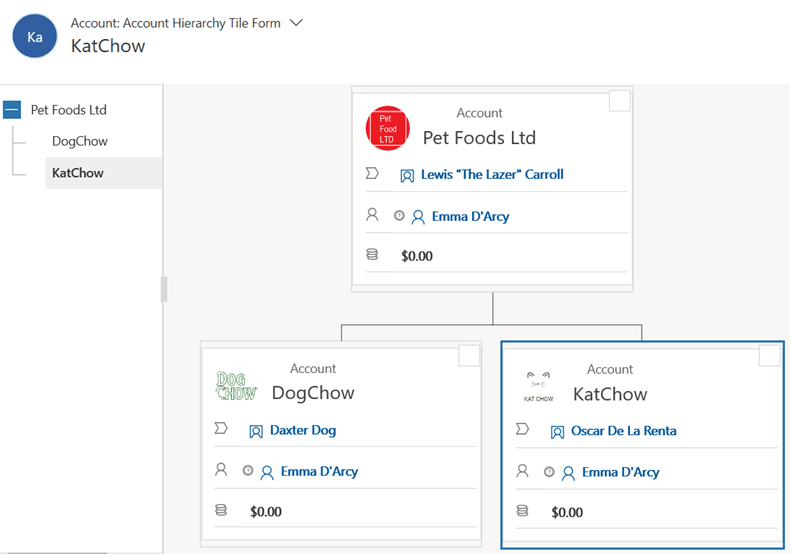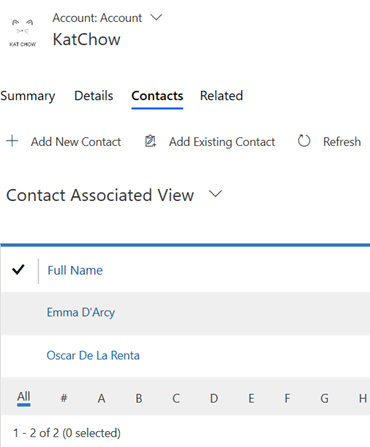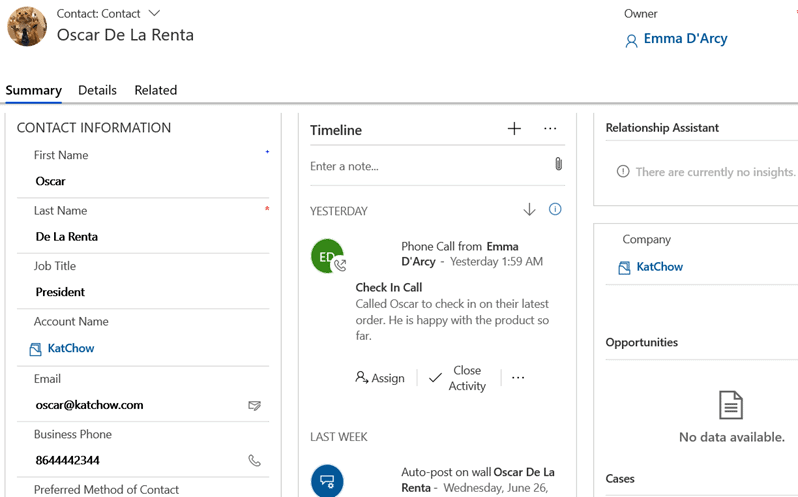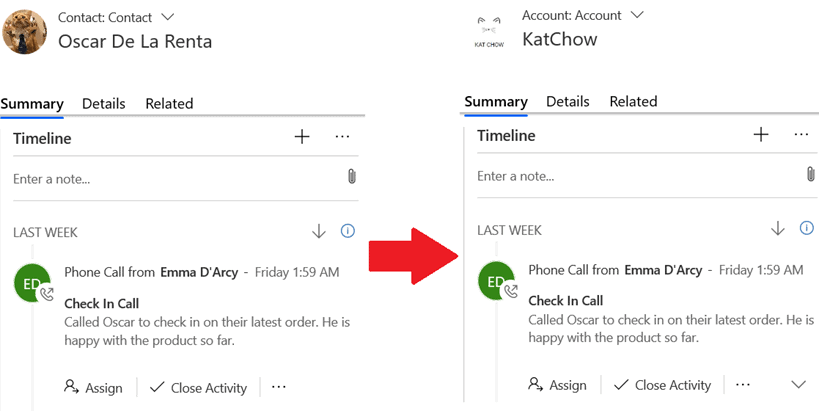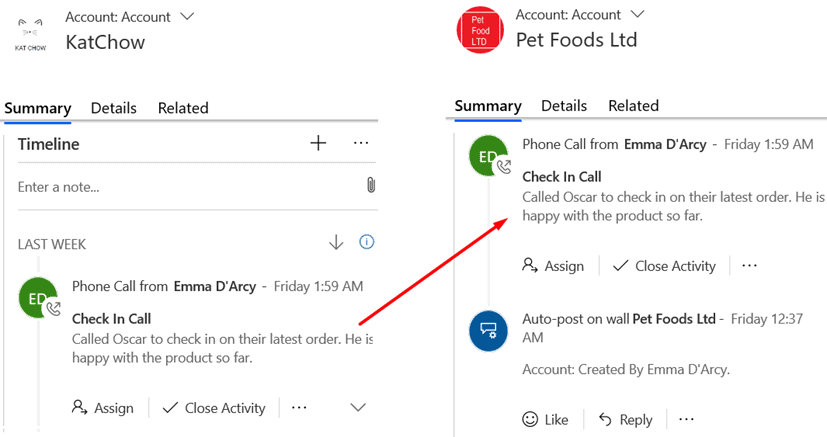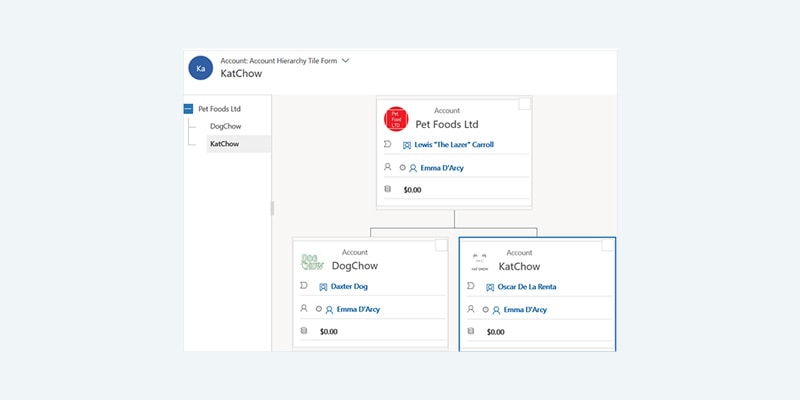
At its most basic level, Dynamics Customer Engagement (also known as Dynamics CE) is a tool that allows you to maintain a virtual Rolodex – it’s a central location where you can easily look up an account, see all the contacts related to that account and if there are any potential related leads. You can easily get a complete picture of your relationship with an organization or person. To get the most out of Dynamics CE, we need to understand the purpose of each record type and how they are related to one another. Let’s look at each of these record types and how they relate back to ClickDimensions.
Accounts
When we talk about an account, we are typically talking about an organization of some kind like a company that is your customer or perhaps a vendor. Sometimes an account may be part of a hierarchy with either a parent account above it or child accounts below, or both! Let’s look at an example:
Here we have the account record for the company named KatChow. We’re able to determine several things about this account at a glance:
- Basic information such as phone, email, relationship type and annual revenue.
- You can see who the primary contact for the account is.
- This account is a child account of Pet Foods Ltd.
- The recent timeline of activities related to this account – we’ll come back to this bit later.
We can also see the hierarchy of the company structure – we can see its parent accounts and/or its child accounts:
Here we can now see the structure of these companies, who the primary contact is, who the record owner is and how much in open opportunities each company has. Overall, the account record is a great place to start when looking for information about a relationship you have with an organization.
When using accounts in conjunction with ClickDimensions, you can email the account if there is email information on the account record.
Contacts
Underneath accounts we will often have contacts. Contacts are people who either have a relationship with the account or are standalone individuals but are generally considered to be people you are currently doing business with or have done business with in the past. In the previous example, we have Oscar De La Renta as the primary contact for the KatChow account. As a user of Dynamics CE, I would assume that the main point of contact for the account is Oscar. We can also have multiple contacts associated with the account:
Now let’s look at what information is available on the contact record:
On Oscar’s record we have access to a lot of information including:
- Related accounts.
- Contact information like email, phone number, address, etc.
- Any activities related to the contact.
- Any related opportunities or cases.
Now that we have a contact with a relationship to an account, we can start to get bigger picture. Any activities that occur on the contact level will now roll all the way up to the account level:
But because KatChow is a child account of Pet Foods Ltd., the activities will also roll up to the very top:
This roll up functionality helps us to get a clear picture of the relationship with the account and contact, giving us maximum visibility on any further actions that are to be taken.
ClickDimensions identifies a contact record by its email address. Because of this, we can email the contact using either the Email, Email 2 or Email 3 field. If an individual submits a form, survey or subscription management using any one of these three email fields, we can tie those submissions back to the record. We also tie back multiple records to the contact such as website page views and visits (once identified). This allows us to get a clearer picture of a contact’s activities.
Leads
It is important to note that not all organizations use leads within their Dynamics CE environment. We use the lead record to track people that we may do business with in the future.
Leads are quite different than contacts in that there are usually a number of fields on the record that allow a business to track information that is useful during the sales process.
On Moose’s record we can see the following:
- Contact info such as phone number and email address.
- Its status in the business process flow.
- How likely is it that the lead will become a qualified lead.
- Any accounts or contacts the lead is related to.
The business process flow at the top of the lead record often helps direct the user through the qualification stages for a lead – these are often customized to the organization’s sales process. Each stage allows the user to determine if the lead is a viable business opportunity. A lead exists in one of three stages: open, qualified or disqualified. While the lead is being looked at as a potential deal, the lead is open. As the lead moves through the business process flow, the business starts to determine if the lead is going to be closed as qualified or closed as disqualified.
ClickDimensions also assists with lead generation through the use of forms. Just like contacts, we use the Email, Email 2 and Email 3 fields to tie records back to. If we do not find a match in Dynamics CE for the email address, we can generate a new lead for the sales team to follow up on.




